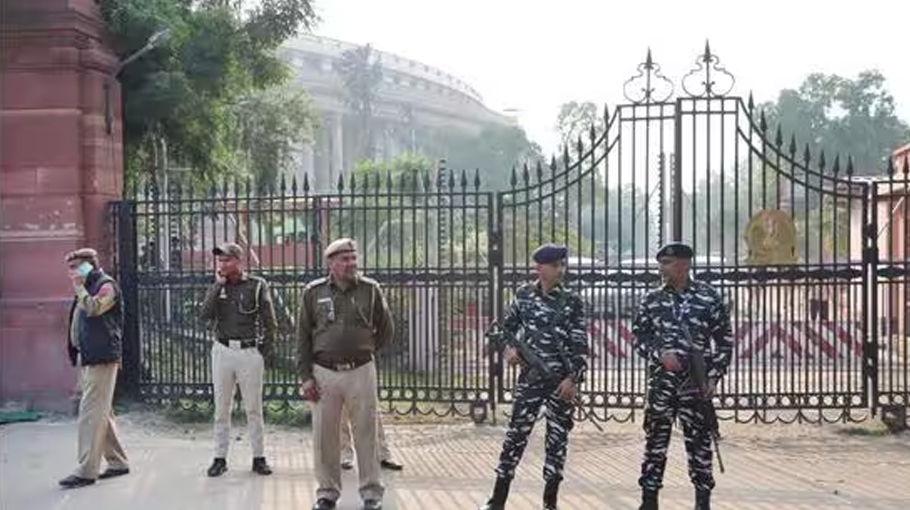Indian Parliament Security

There is a popular saying that there is no smoke without fire. India’s Parliament was the stage of a massive smokeout-cum-disruption on December 13. Chaotic scenes were witnessed inside India’s new Parliament building when two youths leaped into the chambers from the visitors’ gallery above.
They shouted slogans and also set off smoke bombs before they were apprehended. The Parliament was shocked and unsettled by what appears to have been a carefully planned but non-lethal attack.
Parliament proceedings were suspended for two minutes by the acting speaker, Rajendra Aggarwal. One of the suspects was also caught and thrashed by the MPs themselves.
The whole drama was recorded live on mobile cameras by some MPs and flashed on national television. At first, it was feared to be a terrorist strike. Not only because of the threats issued by wanted Khalistan advocate Gurpatwant Singh Pannun, but because Dec. 13 was the twenty-second anniversary of the 2001 attack on the Indian Parliament allegedly by terrorists.
In that attack, as many as eight security personnel and a gardener were killed. There was extensive television coverage of that event, with cameras catching the terrorists live before they were neutralised. Luckily, no member of Parliament was injured or killed. But this year’s Dec. 13 incident should be more appropriately termed a failure in security rather than a terrorist attack.
Yet no one can afford to take the incident lightly. Just imagine what might have happened if, instead of the relatively harmless but highly dense yellow smoke, the assailants had released toxic or poisonous fumes of a deadly gas such as Potassium cyanide. It could have caused dozens if not scores of deaths and serious injuries within a few minutes.
No surprise that the preliminary investigations by the police have revealed that the two men who actually carried out the strike were part of a larger group of at least six. Furthermore, the whole plot was carefully planned and carried out.
This was not a spur-of-the-moment idea. During questioning the accused admitted that they had been planning the attack for nearly a year. They communicated with each other through an app called Signal using encrypted messages. They also were members of a social media page called “Bhagat Singh Fan Club.”
All six had first met in Mysuru, the erstwhile capital of Karnataka state and a large city near Bengaluru, some 18 months back. Over months and with many exchanges, they clarified and consolidated their ideas, intentions, and plans. They also agreed to work in close coordination.
Modus operandi
During an alleged reconnaissance mission during the March Budget Session of Parliament earlier this year, Manoranjan, one of the main accused, had already entered the chamber of the house. Sagar Sharma, too, tried in July 2023. However, he was not permitted inside.
It is during these recce visits that they realised that shoes were not thoroughly checked. So an object relatively small in size could easily be smuggled inside. It was this loophole that they cleverly exploited on Wednesday when they actually succeeded.
According to Delhi Police sources, the group converted in the national capital territory earlier this month, travelling from various states and parts of the country.
OPN DELHI PARLIAMENT
They gathered at the house of Vicky, one of the accused, in Gurugram (Gurgaon). Amol Shinde, another member of the group who hails from Maharashtra, brought multicoloured firecrackers to be set off inside the Parliament. Jha, the ringleader, came last, joining the group on Dec. 11 or 12.
On the day of the breach, they collected the pass to enter the Parliament building from Mysuru BJP MP, Pratap Sharma’s Personal Assistant from Mahadev Road, New Delhi.
While Parliament had descended into panic and chaos, Amol and another accomplice, Neelam Devi from Haryana, shouted slogans, “Tanashahi nahi chalegi” (Dictatorship will not work) outside. They also letting off coloured gas from canisters.
Wake-up call
Jha fled with all their mobile phones. He is still on the run and is being sought by the police. The five who have been apprehended have been charged with trespass, criminal conspiracy, and some more serious offences under the dreaded UAPA or the Unlawful Activities Prevention Act.
What is one to make of this attack on the world’s largest democracy? Without a doubt, it exposes the security lapses and gaps in the system, showing just how vulnerable the Indian Parliament itself and open societies, in general, are to determined opponents and enemies of the system. I am sure that new security measures are already in place following this breach.
In addition, it is also clear that there is a small but committed section of the youth who can be easily turned counter-systemic, whether for ideological or financial reasons. This cannot be dismissed as a lunatic fringe but needs to be taken seriously. Better intelligence and ground monitoring of such disaffected sections of society are also the call of the day.
Finally, to use another idiom, this incident seems to have been more smoke than fire. This prank-attack might actually have done the state some good. A prank-attack rather than a disastrous terrorist strike, it might actually serve as a useful wake-up call to India’s security establishment.
Breaking: As this column goes to press, there is an unfortunate political ruckus in the Indian Parliament over this incident, with the usual blame game. Some members of the opposition have been suspended for unruly conduct.
Looks like it is business as usual in the world’s largest, most vibrant, and some would say unruly, democracy.
Makarand R. Paranjape is a Professor of English at the Jawaharlal Nehru University.
Source: Gulf News


